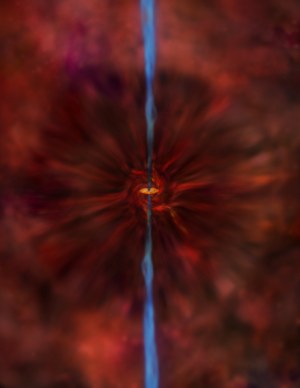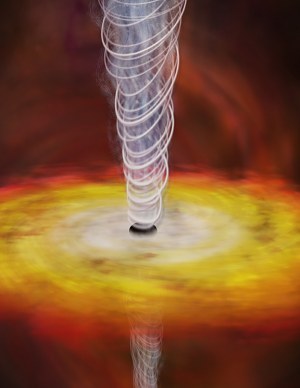The environmental impact of black holes is perhaps a distant and esoteric concept, but US astronomers have used the latest observations of nine black holes with NASA’s Chandra X-ray Observatory to estimate directly the efficiency of black holes. Their calculations show that black holes are perhaps the most fuel efficient engines in the Universe, with a remarkably high fraction of the energy they consume being converted into work.
Just as with cars, it’s critical to know the fuel efficiency of black holes, explains research team leader Steve Allen of the Kavli Institute for Particle Astrophysics and Cosmology at Stanford University, and the Stanford Linear Accelerator Center, Without this information, we cannot figure out what is going on under the hood, so to speak, or what the engine can do.

Black hole
The new Chandra findings reveal that most of the energy released by matter falling toward a supermassive black hole is in the form of high-energy jets travelling at close to the speed of light away from the black hole. This is an important step in understanding how such jets can be launched from magnetized disks of gas near the event horizon of a black hole, the gravitational point of no return beyond which even light cannot escape a black hole’s grip.
Allen and his team investigated nine relatively old, supermassive black holes at the centres of elliptical galaxies. These ancient cosmic beasts were originally thought to be relatively quiet, but the Chandra results had a surprise for the team. All these quiet black holes are producing much more energy in jets of high-energy particles than in visible light or X-rays. These jets create huge bubbles, or cavities, in the hot gas in the galaxies.

Black hole engine
The study showed that while some of the gas first pulled towards the black holes is simply blown away by the energetic activity before it gets so close as to be trapped, a significant fraction must eventually approach the event horizon. At this point, the black hole converts this fuel with incredibly high efficiency into powerful jets that eject matter at enormous speeds. These black holes are very efficient, but it also takes a very long time to refuel them, several million years in fact, Allen adds. Nevertheless, If a car was as fuel-efficient as these black holes, it could theoretically travel over a billion miles on a gallon of gas, says colleague Christopher Reynolds of the University of Maryland, College Park.

Steve Allen
Understanding the workings of black holes has important implications for explaining how galaxies evolve. This study shows that the energy transferred to the hot gas by the black hole jets can preclude the hot gas from cooling and so prevent billions of new stars from forming. This places strict limits on the growth rate of the largest galaxies and essentially prevents galactic sprawl from taking over the neighbourhood.
The efficiency, in terms of E=mc2, is still only about 2.5%, Allen told Spotlight, which is, nevertheless, large when compared to terrestrial sources.
Further reading
Monthly Notices of the Royal Astronomical Society, 2006, in press
http://www3.interscience.wiley.com/journal/117974593/home
Steven Allen
http://www.stanford.edu/dept/physics/people/faculty/allen_steven.html
Chandra X-ray Observatory
http://www.nasa.gov/centers/marshall/news/chandra/
Suggested searches
black holes